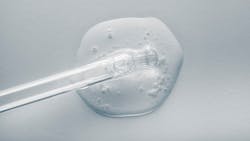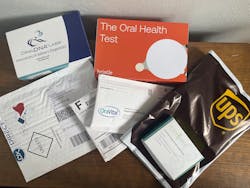Putting saliva tests to the test: Comparing salivary diagnostics
Saliva—you know, the stuff that turns toxic to our patients the moment they sit in our operatory chair. We know it’s essential to have ample and good-quality saliva to support the health of soft and hard tissues in the oral cavity.1 But can you tell by looking at a patient’s saliva how pathogenic it might be? Have you struggled with some patients to figure out why you can’t bring them to health or get them to understand their disease? This is where salivary diagnostics can help make the unseen seen.
Last year at my annual physical, my labs indicated high cholesterol. I understood the numbers before me, but I felt fine and certainly didn't think anything was wrong. But given the data, I spent the last year committed to my health. When this year’s labs returned, I saw the results of my daily workouts and healthy eating. Motivated by the realization that my numbers could change without my really knowing it, I’m more committed than ever to continue working hard for my well-being.
What if we could do the same thing for our patients—more than the slightly subjective probing or bleeding because we “poked” them? We could show them diagnostic tests unveiling which bugs they have, and what that may mean for their oral and overall health. Saliva has discoverable components that can help you formulate an individualized treatment plan2—and eventually, see if that plan is working.
Also by Amanda Hill: Which disinfectant wipe is best?
So how do you know where to begin? Numerous salivary diagnostic companies are out there, and more are entering the market. I decided to throw my spit into the ring and put some of the most popular companies to the test. What I discovered is they’re all different. They vary in the bugs they look for, how samples are collected and tested, and the training and follow-up they offer. It’s a little overwhelming to understand what all of it means.
I wasn’t alone in that feeling. I’ve heard from many clinicians that they tried salivary diagnostics but didn’t understand what to do with the results, so they stopped. But I discovered through this journey that you learn as you go; these tests don’t offer a silver bullet, but they show us how well we are treating or slowing this episodic disease. These tests don’t tell the whole story, but they are a piece that helps us understand what works and what doesn’t.
In your journey, you might want to try out more than one test as you learn and explore this new tool. All the companies offer promotions on team testing so you can start learning from one another to build confidence. No matter what, don’t wait until you’re an expert to incorporate this tool, or you will never start.
Different species detected
All of these tests look at the bad actors of oral disease. Most of them aren’t looking at all the players but the worst of the worst when it comes to periodontal disease and maybe caries. Arguably, there are still virulent pathogens in health, but in disease, there is a shift where the bad guys take a higher concentration. Salivary diagnostics allow you to see that change in the composition of the biofilm load as you work toward health.
As noted in the table, the companies listed test for different species. Some test for five periodontal pathogens, others for 11, and others branch out to candida, Strep mutans, and more. OralDNA has multiple tests. You can add additional tests for up to 21 days without taking a new sample. This could come in handy if you wanted to go back and check for candida or Strep mutans after seeing the perio results.
They also have a test that looks for genotypes that could be an indicator of increased susceptibility to certain diseases. I learned I have the IL-6 gene, which could potentially put me at a higher risk for perio. Good thing I’m a hygienist! The Bristle test gives you a comprehensive list of the microbes hanging out in your saliva.
Measurement tools and sensitivity
All the tests evaluated use quantitative polymerase chain reaction (qPCR), with the exception of Bristle, which uses next-generation sequencing (NGS). These two tools for testing work differently. qPCR looks for specific predetermined species—for instance, AA, PG, Fn—and quantifies them. In contrast, NGS identifies the abundance of every known species and strain present and measures the community as a whole, with each species or strain measured in relation to the other species or strains present.
Diving into them brings back memories of microbiology, and that was hard. Having a list of everything present, like in NGS, gives you a lot of fascinating information. But all that information could be overwhelming, especially when we don’t know what to do with much of it, even though we are learning more every day. Since qPCR has a focused scope, you know what to expect and can narrow down your expertise.
If comparing reports from different companies, pay attention to how the species are measured. Among the qPCR tests, the sensitivity varies. HR5 measures bacteria at 101 while OralDNA and MicrobeLinkDX measure at 103. There is debate over what’s ideal. NGS measures in percentages of species and strains present, so you don’t get an actual number but a measure of how much is present in relation to other species present.
Collection technique
Sample collection and mailing vary with each company. With Bristle, you spit into a tube with a preservative to protect the sample from growing anything during shipping. They have cute scratch-and-sniff stickers to get the saliva flowing.
OralDNA has you swish with a saline solution and spit it into a tube and then add a preservative. MicrobeLinkDX and OraVital use four to five paper points you place in different pockets throughout the mouth to get an idea of what’s going on deep down. OraVital also adds a tongue brush to retrieve a sample from the back of the tongue.
Direct Diagnostics provides gum to stimulate saliva, and then you spit into a tube. There is no preservative, so this sample needs to be refrigerated and mailed with an ice pack within five days to prevent growth. The rest can wait 14 days or longer before shipping. If you do a lot of these, it could be handy to batch mail and take advantage of bulk pricing.
Report and treatment guidance
All the companies offer initial and follow-up training for your team. The timing varies, and there is a mix of on-demand and live training. I was particularly impressed with MicrobeLinkDX. When I called to ask questions about my report, the RDH/CEO of the company picked up the phone!
The reports vary in depth but all include interpretation of the sample, treatment recommendations, home-care suggestions, and follow-up. Some companies offer systemic antibiotic guidelines. OraVital provides a proprietary treatment recommendation that can include antibiotic rinses and gels available for purchase.
Remember that any recommendations in the report are just that, recommendations. OralDNA and MicrobeLinkDX call them “treatment considerations” to be determined by the health-care professional. You are the clinician who has all the data, and salivary diagnostics are just one piece.
Where is salivary diagnostics headed?
We are at the beginning of this marathon, and the assessment toolbox continues to grow. But this is a fast-growing market. There are salivary tests on the horizon to look for early oral cancers3 or even to check for vitamin deficiencies.4 Scientists are looking into how to get accurate diagnostics using saliva instead of a needle. What a faster and less invasive way to get a clearer picture of what’s going on with our patients.
The results of my testing
Analyzing my results had me calling some of my RDH friends experienced with testing and company educators to understand what it all means. There were curious differences in the findings, some due to collection methods and sensitivities, others I’m still diving into. Filtering all of this through my dental mind, I’ll be tailoring the treatment considerations to fit my needs and comfort level. I’m definitely looking into my gut health and maybe adding a probiotic. But you can bet I’m not missing my next hygiene appointment.
This is a lot to consider; I understand the clinicians who avoid it because they’re overwhelmed. But this is a fantastic opportunity to elevate the care we provide with objective health measurables and start an intelligent conversation about treating disease with our patients. Again, don’t wait until you are an expert at this; you’ll never start. This is an exploration.
Editor's note: This article appeared in the October 2023 print edition of RDH magazine. Dental hygienists in North America are eligible for a complimentary print subscription. Sign up here.
References
- Ar P, Gulati A, Mehta D, Sugandhan S. Diagnostic applications of saliva in dentistry. Int J Clin Pediatr Dent. 2009; 2(3):7-13. doi:10.5005/jp-journals-10005-1012
- Tiwari M. Science behind human saliva. J Nat Sci Biol Med. 2011;2(1):53-58. doi:10.4103/0976-9668.82322
- Li Q, Ouyang X, Chen J, Zhang P, Feng Y. A review on salivary proteomics for oral cancer screening. Curr Issues Mol Biol. 2020;37:47-56. doi:10.21775/cimb.037.047
- Logan D, Wallace SM, Woodside JV, McKenna G. The potential of salivary biomarkers of nutritional status and dietary intake: a systematic review. J Dent. 2021;115:103840. doi:10.1016/j.jdent.2021.103840.
About the Author

Amanda Hill, BSDH, RDH, CDIPC
Amanda Hill, BSDH, RDH, CDIPC, is an enthusiastic speaker, innovative consultant, and award-winning author who brings more than 25 years of clinical dental hygiene and education to dentistry. Recipient of ADS’s Emerging Infection Control Leader award and an active participant with the advisory board for RDH magazine, DentistryIQ, and ADS’s Infection Control in Practice Editorial Review Board and membership committee, Amanda (also known as the Waterline Warrior) strives to make topics in dentistry accurate, accessible, and fun. She can be reached at [email protected].

